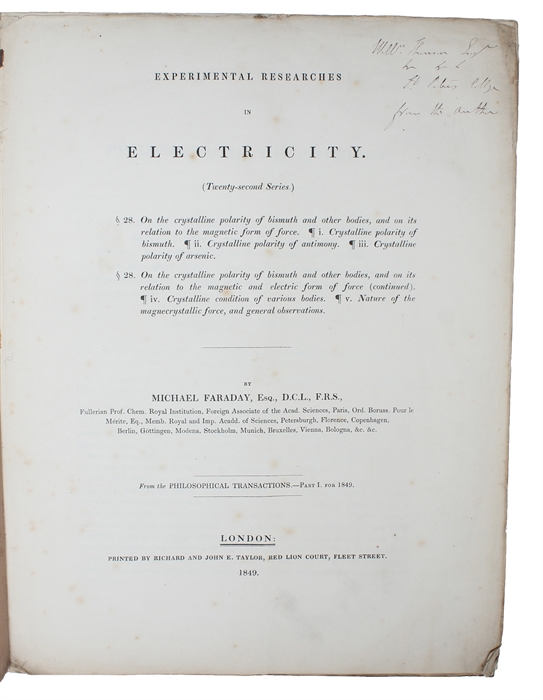INSCRIBED BY FARADAY TO LORD KELVIN
FARADAY, MICHAEL.
Experimental Researches in Electricity. (Twenty-second Series). [Offprint: Philosophical Transactions, Part 1 for 1849].
London: Richard and John E. Taylor, 1849.
Large 4to. (300x231mm). Original blank wrappers. Some small tears. Back strip proffesionally repaired with Japanese paper. With presentation-inscription by Faraday in ink on title page: "William Thomson Esq. | St. Peters College | from the Author." (2),41,(1:blank) pp.
First edition, rare offprint-issue, of "one of the great classics of chemistry and physics". With an extremely attractive presentation-inscription from Faraday to William Thomson (later Lord Kelvin), who delivered the first mathematical exposition of Faraday's researches in electricity. Thomson provided an important theoretical direction for Faraday's interpretation of his own experiments and the two colleagues motivated and inspired each other to a degree that the research and knowledge of electricity they possessed and published would not have would have been reached until many years later.
The paper itself is of the utmost importance, since much of Faraday's groundbreaking research published in 1831-1839 contained many shortcomings and errors which are corrected in this publication. "The corrected second edition of volume 1 is preferred, because the first edition (London 1839) contained many errors". (Neville, Historical Chemical Library).
"In June 1849 William Thomson wrote to Michael Faraday suggesting that the concept of a uniform magnetic field could be used to predict the motions of small magnetic and diamagnetic bodies. [...] There had been an important exchange of ideas between the two, who had a common interest in explaining voltaic, electrostatic, magnetic, optical, and thermal phenomena. They meet every year between 1845 (where they became acquainted) and 1849". (Gooding, Faraday, Thomson, and the Concept of the Magnetic Field).
In 1845 Thomson gave the first mathematical development of Faraday's idea that electric induction takes place through an intervening medium, or "dielectric", and not by some imprecise "action at a distance". He also devised a hypothesis of electrical images, which became a powerful agent in solving problems of electrostatics, or the science which deals with the forces of electricity at rest. It was partly in response to his encouragement that Faraday undertook the research in September 1845 that led to the discovery of the Faraday Effect, which established that light and magnetic (and thereby electric) phenomena were related.
Faraday was also the direct cause of William Thomson's work on the transatlantic submarine telegraph cable. In 1854, Faraday had demonstrated how the construction of a cable would limit the rate at which messages could be sent, which later would be termed the bandwidth. Thomson immediately looked into the problem and published his response the same month Faraday had published his observations. Thomson expressed his results in terms of the data rate that could be achieved and the economic consequences in terms of the potential revenue of the transatlantic undertaking. In 1855, Thomson stressed the impact that the design of the cable would have on its profitability.
Thomson's work on the cable consequently resulted in a complete system for operating a submarine telegraph that was capable of sending a character every 3.5 seconds. He patented the key elements of his system, the mirror galvanometer and the siphon recorder, in 1858.
From 1831 to 1852, Michael Faraday published his "Experimental Researches in Electricity" in The Philosophical Transactions of the Royal Society. These papers contain not only an impressive series of experimental discoveries, but also a collection of heterodox theoretical concepts on the nature of these phenomena expressed in terms of lines of forces and fields. He published 30 papers in all under this general title. They represent Faraday's most important work, are classics in both chemistry and physics, and are the experimental foundations for Maxwell's electro-magnetic theory of light, using Faraday's concepts of lines of force or tubes of magnetic and electrical forces. His many experiments on the effects of electricity and magnetism presented in these papers lead to the fundamental discoveries of 'induced electricity' (the Faraday current), the electronic state of matter, the identity of electricity from different sources, equivalents in electro-chemical decomposition, electrostatic induction, hydro-electricity, diamagnetism, relation of gravity to electricity, atmospheric magnetism, and many others.
"Among experimental philosophers Faraday holds by universal consent the foremost place. The memoirs in which his discoveries are enshrined will never cease to be read with admiration and delight; and future generation will preserve with an affection not less enduring the personal records and familiar letters, which recall the memory of his humble and unselfish spirit." (Whittaker, A History of the Theories of Aether & Electricity, p. 197).
Order-nr.: 38043


![Experimental Researches in Electricity. (Twenty-second Series). [Offprint: Philosophical Transactions, Part 1 for 1849].](/images/product/38043b.jpg)
![Experimental Researches in Electricity. (Twenty-second Series). [Offprint: Philosophical Transactions, Part 1 for 1849].](/images/product/38043c.jpg)
![Experimental Researches in Electricity. (Twenty-second Series). [Offprint: Philosophical Transactions, Part 1 for 1849].](/images/product/38043d.jpg)